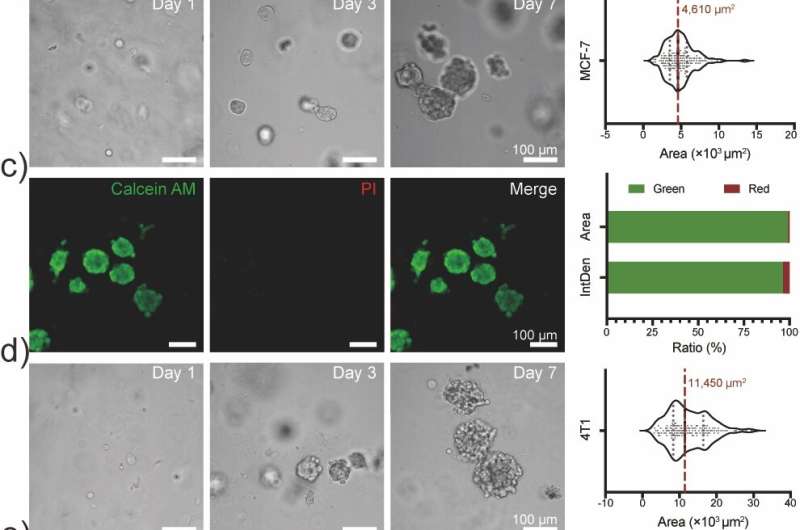

| Date | 4th, Mar 2022 |
|---|
 a) Flowchart of spheroid formation and extraction. Representative MCF-7 b) and 4T1 d) spheroids after 1, 3, and 7 days; the right panel shows the cross-sectional area distribution of spheroids. Live-dead staining of 7-day-cultured MCF-7 c) and 4T1 e) spheroids released from SupraGel; the right panel shows the corresponding area or integrated density of green and red fluorescence. Credit: Science China Press
a) Flowchart of spheroid formation and extraction. Representative MCF-7 b) and 4T1 d) spheroids after 1, 3, and 7 days; the right panel shows the cross-sectional area distribution of spheroids. Live-dead staining of 7-day-cultured MCF-7 c) and 4T1 e) spheroids released from SupraGel; the right panel shows the corresponding area or integrated density of green and red fluorescence. Credit: Science China Press
Prof. Zhimou Yang, who has wored in the research field of peptide self-assembly biomaterials for more than 15 years, has designed a peptide hydrogel for cell spheroids production. "Supramolecular hydrogels of self-assembling short peptides are promising for cell 3D culturing because they are biocompatible and are composed of nanofibers similar to the extracellular matrix. However, peptide hydrogels for cell spheroid production are rarely reported." Prof. Zhimou Yang says.
The peptide that formed the hydrogel contained two parts: one is the self-assembling part that contains biotin groups and the other is the bioactive part for regulating cell adhesion and growth. Peptide fragments derived from laminin and an integrin-binding peptide are encoded into the peptide sequence of the bioactive part.
The hydrogel formed by the supramolecular self-assembling of this peptide is termed "SupraGel" by the team. The team in Prof. Yang's lab performed rheological measurements of SupraGel and found that it could transform into a solution by simply vigorously shaking by hand, and the resulting solution could form a hydrogel again after approximately 10 min. "These features are critical for incorporating cells and isolating cell spheroids." Prof. Yang says.
Yang's team cultured several kinds of cancer cells in SupraGel. After 7 days of growth, each single cell divided into many cells and formed spheroids spontaneously. Then they collaborated with Prof. Quan Chen, who is an expert in cell biology, to test whether SupraGel was suitable for stem cell culturing and spheroid production.
The researchers found that intestinal stem cells (ISCs) could grow into spheroids after 15 days of cell culture in SupraGel. They also compared ISCs spheroids in both SupraGel and commercially available Matrigel and found that SupraGel helped to maintain the stemness of ISCs during the formation of the spheroids better than Matrigel did.
"We envision significant potential for SupraGel in cell spheroid preparation and a range of related applications, such as studying cellular complexities and screening drugs." Prof. Yang says.
The research was published in Science China Materials .
More information: Sifan Ai et al, A SupraGel for efficient production of cell spheroids, Science China Materials (2022). DOI: 10.1007/s40843-021-1951-x
Citation: A peptide hydrogel for efficient production of cell spheroids (2022, March 4) retrieved 6 June 2022 from https://phys.org/news/2022-03-peptide-hydrogel-efficient-production-cell.html
This document is subject to copyright. Apart from any fair dealing for the purpose of private study or research, no part may be reproduced without the written permission. The content is provided for information purposes only.
